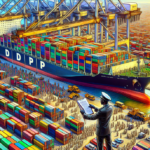Understanding the Difference Between DDP and DAP Shipping Terms
When it comes to international shipping, selecting the right Incoterms is crucial for managing costs and responsibilities effectively. Two commonly used terms are Delivered Duty Paid (DDP) and Delivered at Place (DAP). This guide provides a comprehensive overview of these shipping terms, exploring their definitions, legal implications, and practical applications to help businesses make informed decisions.
What Do DDP and DAP Stand for in Shipping Terms?
DDP stands for Delivered Duty Paid, while DAP stands for Delivered at Place. Both are part of the Incoterms 2020, established by the International Chamber of Commerce (ICC), which define the responsibilities of buyers and sellers in international trade.
Delivered Duty Paid (DDP)
Under DDP, the seller assumes most of the responsibility, including arranging and paying for transportation, insurance, and import duties. The seller delivers the goods to the buyer’s premises, minimizing the buyer’s involvement in the shipping process.
Delivered at Place (DAP)
With DAP, the seller is responsible for delivering the goods to a specified location, such as a port or warehouse. However, the buyer handles import duties, taxes, and subsequent transportation to the final destination.
An Overview of International Shipping Terms
Incoterms consist of 11 standardized terms categorized based on the division of responsibilities between buyers and sellers. These terms help clarify the point at which risk and cost transfer from the seller to the buyer.
- EXW (Ex Works)
- FCA (Free Carrier)
- CPT (Carriage Paid To)
- CIP (Carriage and Insurance Paid To)
- DAP (Delivered at Place)
- DDP (Delivered Duty Paid)
- FAS (Free Alongside Ship)
- FOB (Free on Board)
- CFR (Cost and Freight)
- CIF (Cost, Insurance, and Freight)
Understanding these terms is essential for managing logistics, costs, and legal responsibilities effectively.
How Do DDP and DAP Shipping Terms Impact Your Business?
The choice between DDP and DAP can significantly affect a business's logistics strategy, cost structure, and risk management. Here's how:
Impact of DDP
- Cost Control: Sellers bear all costs until the goods reach the buyer, providing simplicity for the buyer.
- Risk Management: Sellers assume more risk, which may be challenging for smaller businesses.
- Cash Flow: Sellers must manage upfront costs, potentially affecting cash flow.
Impact of DAP
- Shared Responsibilities: Sellers handle transportation to a specified point, while buyers manage additional costs and logistics.
- Flexibility: Buyers have more control over the final leg of the shipment, allowing for tailored logistics solutions.
- Risk Distribution: Risks are split, reducing the burden on sellers.
Pros and Cons of DDP and DAP Shipping Terms
Each shipping term has its advantages and disadvantages, depending on the business's specific needs and capabilities.
Pros of DDP
- Simplicity for Buyers: Buyers receive goods without worrying about additional costs or logistics.
- Enhanced Customer Experience: Streamlined delivery can improve buyer satisfaction and loyalty.
Cons of DDP
- Higher Responsibility for Sellers: Sellers must navigate complex import regulations and bear all related costs.
- Increased Risk: Any delays or issues during transit are the seller’s responsibility.
Pros of DAP
- Balanced Responsibility: Sellers manage the primary logistics, while buyers handle final delivery.
- Cost Management: Sellers can control major shipping costs, with buyers managing local expenses.
Cons of DAP
- Complexity for Buyers: Buyers must arrange and pay for the final delivery, adding complexity.
- Potential for Disputes: Misunderstandings about responsibilities can lead to conflicts.
Legal Implications of Using DDP and DAP Shipping Terms
Understanding the legal responsibilities associated with DDP and DAP is essential to avoid compliance issues and disputes.
DDP Legal Responsibilities
- Import Compliance: Sellers must ensure all import licenses and permits are obtained.
- Duties and Taxes: Sellers are responsible for calculating and paying all applicable duties and taxes.
- Documentation: Accurate and complete documentation is crucial to prevent delays at customs.
DAP Legal Responsibilities
- Import Duties and Taxes: Buyers handle the payment and compliance of import duties and taxes.
- Local Regulations: Buyers must be aware of and comply with local laws and regulations at the delivery point.
Responsibilities of Importers and Exporters in DDP and DAP Shipping Terms
Clear delineation of responsibilities helps prevent misunderstandings and ensures smooth transactions.
Exporters' Responsibilities under DDP
- Arrange transportation to the buyer's location.
- Handle export and import customs clearance.
- Pay all duties, taxes, and fees.
Importers' Responsibilities under DDP
- Receive and unload the goods.
- Handle any additional inland logistics if necessary.
Exporters' Responsibilities under DAP
- Arrange transportation to the specified delivery point.
- Handle export customs clearance.
Importers' Responsibilities under DAP
- Handle import customs clearance.
- Arrange and pay for final delivery from the agreed location.
Choosing Between DDP and DAP Shipping Terms for Your Business
Selecting the appropriate Incoterm requires evaluating various factors that align with your business objectives and capabilities.
Considerations for Choosing DDP
- Customer Convenience: Ideal for businesses aiming to provide a hassle-free experience.
- Market Control: Suitable when the seller has strong logistics networks in the destination country.
- Risk Appetite: Best for sellers willing to assume higher risk and responsibility.
Considerations for Choosing DAP
- Shared Logistics: Suitable for partnerships where both parties have robust logistics capabilities.
- Cost Distribution: Helps in distributing costs more evenly between buyer and seller.
- Flexibility: Offers flexibility to buyers for managing the final delivery according to their preferences.
Common Challenges Faced by Businesses Using DDP or DAP
Adopting DDP or DAP involves navigating several challenges that can impact the efficiency and cost-effectiveness of your supply chain.
Challenges with DDP
- Regulatory Compliance: Navigating complex import regulations can be daunting.
- Cost Management: Upfront costs for duties and taxes can affect cash flow.
- Risk of Delays: Any delays in transit are the seller’s responsibility, potentially harming customer satisfaction.
Challenges with DAP
- Coordination Complexity: Coordinating between different logistics providers can be challenging.
- Increased Buyer Responsibility: Buyers must manage additional logistics, which may require more resources.
- Potential for Disputes: Ambiguities in responsibilities can lead to disputes over damages or delays.
Best Practices for Implementing DDP or DAP Shipping Terms
Implementing DDP or DAP effectively involves strategic planning and adherence to best practices to ensure seamless operations.
Clear Communication
- Define responsibilities clearly in the contract.
- Maintain open lines of communication with all stakeholders.
Partner with Reliable Shipping Providers
- Choose experienced logistics partners with expertise in international shipping.
- Ensure partners are knowledgeable about local regulations and customs procedures.
Effective Documentation
- Ensure all necessary documents are accurately completed and submitted on time.
- Implement a robust tracking system to monitor shipments in real-time.
Regular Review and Assessment
- Continuously evaluate the effectiveness of your shipping terms.
- Adjust strategies based on performance metrics and feedback.
Insurance Coverage for Shipments Under DDP and DAP Incoterms
Insurance is vital to protect against potential losses during transit. Understanding insurance responsibilities under DDP and DAP is essential.
Insurance under DDP
- Seller's Responsibility: Sellers must obtain insurance that covers the goods until they reach the buyer’s premises.
- Coverage: Comprehensive coverage is recommended to protect against various risks.
Insurance under DAP
- Buyer’s Responsibility: Buyers should arrange insurance once the goods reach the agreed delivery point.
- Coverage: Ensure insurance covers the final leg of transportation to the ultimate destination.
Utilizing reputable insurance providers and understanding the scope of coverage can mitigate financial risks associated with international shipping.
Addressing Disputes Arising from DDP or DAP Incoterms
Disputes can arise from misunderstandings or disagreements over responsibilities. Implementing effective dispute resolution mechanisms is crucial.
Preventive Measures
- Clear Contracts: Ensure contracts explicitly outline the responsibilities under DDP or DAP.
- Training: Educate your team on the specifics of the chosen Incoterms.
Resolution Strategies
- Negotiation: Attempt to resolve disputes through direct negotiation between parties.
- Mediation: Engage a neutral third party to facilitate a resolution.
- Arbitration: Use arbitration services for binding resolutions if negotiations fail.
- Legal Action: As a last resort, pursue legal action to resolve disputes.
Maintaining good communication and establishing clear agreements can significantly reduce the likelihood of disputes and ensure smooth international transactions.
Real-Life Examples of DDP and DAP in Action
Understanding how businesses apply DDP and DAP can provide practical insights into their advantages and challenges.
DDP Example
A small e-commerce retailer selling handmade jewelry to customers in Europe may choose DDP to provide a seamless purchasing experience. By handling all shipping logistics and duties, the retailer ensures customers receive their orders without unexpected costs or delays, enhancing customer satisfaction.
DAP Example
A large manufacturing company exporting machinery to international distributors might opt for DAP. By delivering the machinery to a port in the destination country, the company maintains control over the main transportation leg while allowing distributors to handle local delivery logistics, optimizing overall supply chain efficiency.
Conclusion
Choosing between DDP and DAP shipping terms depends on your business's specific needs, resources, and risk tolerance. By understanding the responsibilities, legal implications, and potential challenges associated with each term, you can make informed decisions that enhance your international shipping strategies and strengthen your global business operations.






















